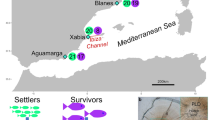Abstract
A NEW interest in the problems of taxonomy and migration of Atlantic eels1–5 was aroused by Tucker1 when he advocated a hypothesis radically different from Schmidt's generally accepted picture of the natural history of Atlantic eels6. According to Schmidt, the American and the European fresh water eels constitute two separate species, Anguilla rostrata and A. vulgaris. These can be distinguished by morphological characters such as the numbers of vertebrae. Both species migrate to spawning areas in the Sargasso Sea. Tucker finds it unlikely that European eels can accomplish the inferred return journey to the remote breeding place. American eels, however, have a much shorter distance to cover and may be guided by favourable sea currents. Thus, Tucker concludes that only American eels contribute to the propagation of the Atlantic eel population, which should therefore be genetically homogeneous and constitute one species. The morphological differences are thought by Tucker to be environmentally induced by differences in water temperature encountered by the early stages of the two groups of larvae that will eventually reach American or European coastal waters.
This is a preview of subscription content, access via your institution
Access options
Subscribe to this journal
Receive 51 print issues and online access
$199.00 per year
only $3.90 per issue
Buy this article
- Purchase on Springer Link
- Instant access to full article PDF
Prices may be subject to local taxes which are calculated during checkout
Similar content being viewed by others
References
Tucker, D. W., Nature, 183, 495 (1959).
D'Ancona, U., Nature, 183, 1405 (1959).
Jones, J. W., Nature, 184, 1281 (1959).
Deelder, C. L., Nature, 185, 589 (1960).
Sick, K., Westergaard, M., and Frydenberg, O., Nature, 193, 1001 (1962).
Schmidt, J., Phil. Trans. Roy. Soc., B, 211, 179 (1922).
Sick, K., Hereditas, 54, 19 (1965).
Koch, H. J. A., Bergström, E., and Evans, J. G., Meded. Konik. Acad. Wetensch. Belg., 26, 1 (1964).
Wilkins, N. P., and Iles, T. D., Comp. Biochem. Physiol., 17, 1141 (1966).
Author information
Authors and Affiliations
Rights and permissions
About this article
Cite this article
SICK, K., BAHN, E., FRYDENBERG, O. et al. Haemoglobin Polymorphism of the American Fresh Water Eel Anguilla. Nature 214, 1141–1142 (1967). https://doi.org/10.1038/2141141a0
Received:
Issue Date:
DOI: https://doi.org/10.1038/2141141a0
This article is cited by
-
Introgressive hybridization and latitudinal admixture clines in North Atlantic eels
BMC Evolutionary Biology (2014)
-
Comparison of electrophoretic and meristic characters of 0-group eel larvae from the Sargasso Sea
Helgoländer Meeresuntersuchungen (1982)
-
Electrophoretic evidence for two species of Anguilla leptocephali in the Sargasso Sea
Nature (1980)
-
Origin of the European Eel
Nature (1973)
-
Importance de l'étude des transferrines sériques dans la différenciation des espèces. Résultats acquis dans le genreAnguilla
Experientia (1968)
Comments
By submitting a comment you agree to abide by our Terms and Community Guidelines. If you find something abusive or that does not comply with our terms or guidelines please flag it as inappropriate.



